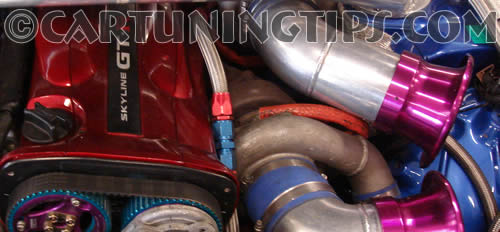Tuners tips on "Fitting a turbo to your car"
We all know that one of the best ways to improve a cars performance is to uprade to forced induction.
In this article we'll look at adding a turbo to your car and the issues you'll need to be aware of.
More air going into the engine means that you can burn more fuel and produce more power.
In video games we often see that turbo upgrades are easy to do and give phenomenal power gains to a car but is it like that in the real world?

If you have too much pressure in an engine then it will cause the fuel to prematurely ignite.
This can lead to serious engine problems so when you add a turbo you need to actually reduce the pressure in the engine.
We do this by lowering the compression ratio. This can be achieved only with some major engine work. Adding a thicker gasket or using 2 gaskets, will do very little to the compression ratio and will make the car less reliable.
Ways to lower the engines compression ratio.
Replacing the pistons with low compression pistons and using a stroker kit to alter the throw of the pistons will potentially reduce the engines compression ratio. Reboring the engine will increase the cylinder capacity but this should be mated to lower compression pistons.
It is also possible on some engines to enlarge the head area around the valves but this would not be very practical or effective. If you are unable or unwilling to reduce the engines compression ratio then your options are restricted to a low pressure forced induction system. You could also use a higher octane fuel, which is by it's very nature more resistant to knock.
It is worth noting that many Japanese cars engines have high compression ratios and already prefer higher octane fuels giving little scope for adding a turbo without substantial internal work. Alternatively a water injection system can dampen the air fuel charge down and delay the effect of premature ignition. There are a number of considerations and drawbacks to water injection so this should only be used in certain situations.
Fitting the turbo
Now that the engine is able to cope with the extra air and fuel without prematurely igniting we have to get the turbo plumbed in. The plumbing requires a custom exhaust header and you will need to route the air intake piping through the turbo. A turbo will need the following components to work properly.

A wastegate to control the flow of exhaust gases through the turbo, a diverter or blow off valve to vent overboost on closed throttle and a good supply of oil. Additionally Car Tuning Tips suggest you fit an intercooler to lower the intake air charge as the turbo compressiong will significantly warm it up.
Because the engine is undergoing a dramatic transformation you will certainly need to alter the timing map. If you get the timing wrong you risk destroying your engine so it is best left in the hands of an expert who can set this up on a rolling road.
Keep a close eye on engine oil temperature, you may need to add an oil cooler if your car starts to overheat. We also suggest you user a higher grade of oil, the engine will be working much harder after all and the heat in a turbo unit can really degrade mineral oils very quickly.
It is certainly a good idea to overhaul an engine thoroughly before adding a turbo charger. Fitting forged parts is a good idea as this will help to maintain the reliability of your engine. A good source of cheap turbos is your local wreckers, breakage or salvage yard. A new turbo can set you back substantial amounts of money.
With turbos being commonly installed on VAG group cars and many Japanese performance cars there should be a good selection to choose from. It is also worth checking the classified adverts for old turbos as many owners uprate their turbos and seek to sell on the old one.
Remember that bigger turbos spool up more slowly and are suited to high revving or large capacity engines. When adding a turbo to a NASP engine the Car tuning tips recommend you stick with a smaller turbo unit and as a bonus you will benefit from a faster spool up and lower lag. A turbo can dramatically increase the power of your engine.
Typically power gains from adding forced induction range from 40% to 200% of your base power although a sensible figure to aim for is around 75-100% of a power increase but this does depend on how strong your base engine is and how much work you have had done on it.
If you have not lowered the compression ratio of your engine or strengthened it then we suggest you stick with a very low boost setting and settle for a 25% power hike. Superchargers are easier to add than a turbo so you should consider this as a low cost, lower hassle alternative to turbo charging.
Check out TorqueCars new YouTube channel, and see their awesome new content...
Feedback
Please use our forums if you wish to ask a tuning question, and please note we do not sell parts or services, we are just an online magazine.
Help us improve, leave a suggestion or tip
One Response to “Fitting a turbo to your car”

This is really good information!! What would it take me to turbo charge an opel 3.0litre 95mm bore straight 6 engine and the measures i should take